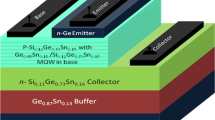Abstract
Charge control model and rate equations have been exploited for the first time in order to glean the optical frequency response of a long-wavelength heterojunction bipolar transistor laser. For a 1.56 μm N-InP/p-InAlGaAs/N-InP fabricated transistor laser with a single quantum well, the optical bandwidth is estimated using this model. All parameters of the mentioned model have been computed for this new type of long wavelength transistor laser. It has been found that frequency response of this optoelectronic device has a 29 dB resonance peak which is not very desirable and is so higher than traditional GaAs transistor lasers. Furthermore, we have illustrated that the resonance peak will decrease and the optical bandwidth will increase, if we increase the width of the quantum well. Finally, we have analyzed that how base width affects on the optical bandwidth and resonance peak of frequency response. It has been proved that, there is a trade-off between larger bandwidth and lower resonance peak for base width effect.
Similar content being viewed by others
References
Asada M.: Gain and intervalence band absorption in QW lasers. IEEE J. Quantum Electron. 20(7), 745–753 (1984)
Berger V.: Three-level laser based on intersubband transitions in asymmetric quantum wells: a theoretical study. Semicond. Sci. Technol. 9, 1493–1499 (1994)
Coldren L.A., Corzine S.W.: Diode Lasers and Photonic Integrated Circuits. Wiley, New York (1995)
Dixon F., Feng M., Holonyak N., Huang Y., Zhang Z.B., Ryou J.H., Dupuis R.D.: Transistor laser with emission wavelength at 1544 nm. Appl. Phys. Lett. 93(2), 021111-1–021111-3 (2008)
Faraji B., Wei S., Pulfrey D.L., Chrostowski L.: Analytical modeling of the transistor laser. IEEE J. Quantum Electron. 15, 594–603 (2009). doi:10.1109/JSTQE.2009.2013178
Feng M., Holonyak N., Walter G., Chan R.: Room temperature continuous wave operation of a heterojunction bipolar transistor laser. Appl. Phys. Lett. 87, 131103 (2005). doi:10.1063/1.2058213
Feng M., Holonyak N., James A., Cimino K., Walter G., Chan R.: Carrier lifetime and modulation bandwidth of a quantum well AlGaAs/InGaP/GaAs/InGaAs transistor laser. Appl. Phys. Lett. 89, 113504–113507 (2006). doi:10.1063/1.2346369
Feng M., Holonyak N., Then H.W., Walter G.: Charge control analysis of transistor laser operation. Appl. Phys. Lett. 91, 053501–053503 (2007). doi:10.1063/1.2767172
Harrison P.: Quantum Wells, Wires and Dots. Wiley, New York (2005)
Holonyak N., Feng M.: The transistor laser. IEEE Spectr. 43(2), 50–55 (2006)
Huang Y., Ryou J., Dupuis R.D.: Epitaxial structure design of a long-wavelength InAlGaAs/InP transistor laser. IEEE J. Quantum Electron. 47(5), 642–650 (2011). doi:10.1109/JQE.2011.2108636
Huang Y., Ryou J., Dupuis R.D., Dixon F., Holonyak N., Feng M.: InP/InAlGaAs light-emitting transistors and transistor lasers with a carbon-doped base layer. J. Appl. Phys. 109, 063106–063112 (2011). doi:10.1063/1.3561368
Kaatuzian H.: Photonics, vol. 1, pp. 193. Amirkabir University of Technology Press, Tehran (2005)
Kaatuzian, H., Rahbardar, H., Taghavi, I.: Optical modulation bandwidth enhancement of heterojunction bipolar transistor lasers using base width variation. In: NUSOD 2011 proceeding (2011)
Smet J.H., Fonstad C.G., Hu Q.: Intrawell and interwell intersubband transitions in multiple quantum wells for far-infrared sources. J. Appl. Phys. 79, 9305–9320 (1996). doi:10.1063/1.362607
Taghavi I., Kaatuzian H.: Gain-bandwidth trade-off in a transistor laser: quantum well dislocation effect. Opt. Quant. Electron. 41, 481–488 (2010). doi:10.1007/s11082-010-9384-0
Then H.W., Feng M., Holonyak N., Wu C.H.: Experimental determination of the effective minority carrier lifetime in the operation of a quantum-well n-p-n heterojunction bipolar light-emitting transistor of varying base quantum-well design and doping. Appl. Phys. Lett. 91, 033505–033508 (2007). doi:10.1063/1.2759263
Zhang L., Leburton J.P.: Modeling of the transient characteristics of heterojunction bipolar transistor lasers. J. Appl. Phys. 45, 359–366 (2009). doi:10.1109/JQE.2009.2013215
Author information
Authors and Affiliations
Corresponding author
Rights and permissions
About this article
Cite this article
Mojaver, H.R., Kaatuzian, H. Analysis and improvement of optical frequency response in a long wavelength transistor laser. Opt Quant Electron 44, 45–54 (2012). https://doi.org/10.1007/s11082-011-9531-2
Received:
Accepted:
Published:
Issue Date:
DOI: https://doi.org/10.1007/s11082-011-9531-2




